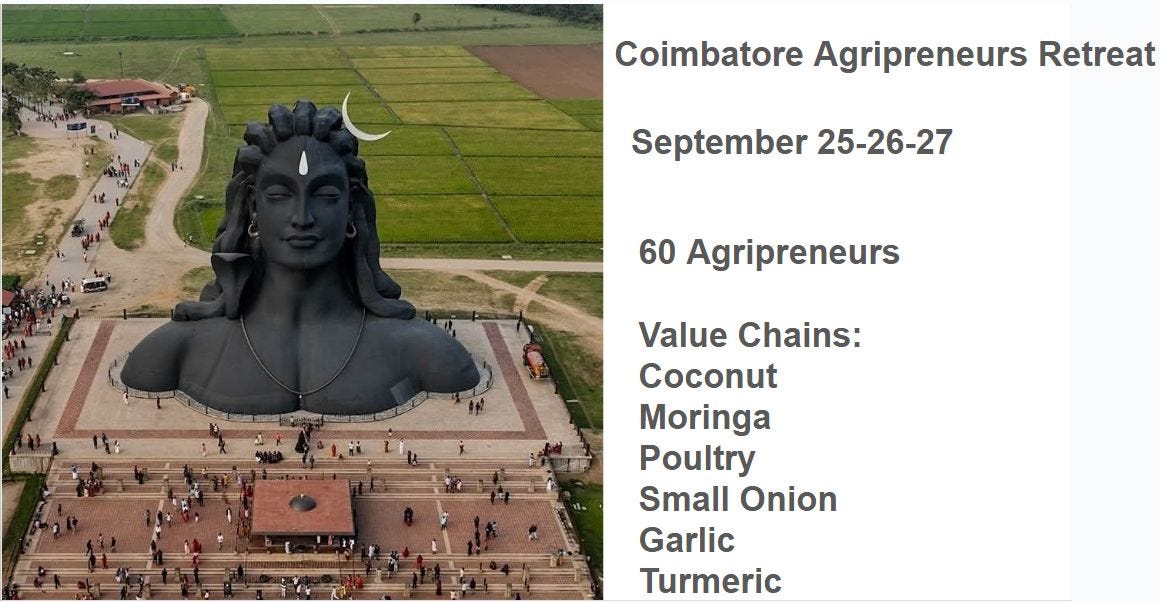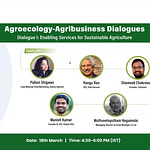<Advertisement>
Registrations Open For the Fifth Agripreneurs Retreat. You can sign up here.

</Advertisement>
State of Bioenergy with Mateen and Ashwin
India has been the third largest emitter (if you measure GHG emissions) in the world since 2019, although per capita share is way lower than world average. In his address at COP26, Prime Minister Modi pledged that India will increase its capacity of non-fossil energy capacity to 500 GW and meet 50 per cent of its energy requirements through renewable energy by 2030.
These are heady times for the Indian bioenergy sector, riding on Indian Government’s mandate. CBG players like Gruner Renewable energy have seen their revenues jump 40X. Maize craze is currently gripping India as we speak, thanks to ethanol demand spiking off the charts to meet 27% blending target by 2030.
How to understand the potential of bioenergy sector? What can biofuel sector learn from the evolution of the automotive sector?
Can bioenergy ride the scaling wave amidst ongoing fodder crisis in India? India has approximately 1,108TWh of biogas potential, according to an analysis conducted by World Biogas Association. What is the potential for biohydrogen in India? What are its scaling levers?
How do we transcend messy food vs fuel debates ? To explore these questions and more, I spoke with two agripreneurs, Mateen Abdul (Grassroots Energy) and Ashwin Save (Biofuel Circle). This conversation was recorded in November 2024.
Here is an edited excerpt that focuses on the crucial pointers of the dialogue:
Venky Ramachandran: Mateen, you've been in the automotive sector for quite some time. How did you transition into bioenergy? Was this always part of your plan?
Mateen Abdul: Thanks for setting the context, Venky. You're right. I started my career in automotive, building businesses in large companies. I wanted to move into clean energy, though it was quite early back then. I realized sustainability would be a key focus area going forward. After spending time at a startup understanding the challenges, my colleague and I formed Grassroots Energy about seven years ago. We deliberately avoided solar or wind because of their limited local impact. Bio offered a multi-pronged approach impacting communities locally while providing solutions to stakeholders including corporates. That was our motivation.
Venky Ramachandran: Ashwin, you and I share a technology background who got into agriculture. I've heard wonderful things about Biofuel Circle's journey from your investors at Spectrum Impact. How did you get into this trajectory?
Ashwin Save: I actually started as a crude oil trader. I'm a mechanical engineer and MBA by training, but I've been coding ever since I was a kid. I spent several years trading crude oil, naphtha, and petroleum products with HPCL, then moved to a software company focused on energy trading and risk management.
When my co-founder Suhas and I got together in early 2020, we were struck by a fundamental question: there's so much potential in this space: Why hasn't it been tapped yet? We felt the farm-to-fuel supply chain had significant inefficiencies ripe for digital intervention.
My background in commodities, technology, and energy commodities, combined with Suhas’s experience in growing companies, seemed to connect perfectly. Biofuel Circle was created in June 2020, right in the middle of the pandemic.
We believe we're at a perfect storm—the convergence of widespread smartphone adoption, data availability, improved payment ecosystems, conducive policy frameworks, and growing awareness toward alternative energy. This allows us to tap into the estimated 235 million tons of agricultural residue that goes to waste annually in India.
Learning from the Automotive Sector
Venky Ramachandran: Mateen, coming from automotive to bioenergy, what insights from the auto sector are obvious there but we've yet to learn in bioenergy?
Mateen Abdul: It's worth noting that the automotive sector took over 100 years to evolve, and it's not just one sector—it's multiple subsectors. While bioenergy has had instances here and there, several things are now coming together.
There are three critical pillars for any sector to grow: policy, pull, and push.
Policy: We now have granular policies—for ethanol, pellets, feedstock aggregation. The G20 Biofuel Alliance has expanded this to a global canvas, moving beyond single countries to multiple nations collaborating.
Pull: This has really taken off in the last 2-3 years. Large corporates have signed up for carbon-neutral goals. In India, the top 1,000 companies must now voluntarily disclose their carbon emissions—this may become mandatory over time. There's also ESG pressure from stakeholders and shareholders.
What's exciting is that many of our solutions are now cheaper than existing fossil fuels, creating financial incentives beyond sustainability. Most importantly, many solutions are drop-in fuels—requiring minimal capital expenditure for customers to switch over.
Push: This is where entrepreneurs like us come in. A range of technologies are now available across solid fuels, gaseous fuels, with significant investments flowing in. We're seeing opportunities for hydrogen, sustainable aviation fuel, and high-value products like biopolymers, sustainable packaging, cosmetics components. It's not just restricted to fuels anymore.
The Energy Transition Challenge
Venky Ramachandran: Ashwin, how do you frame the thesis for energy transition, given the enormity of our energy needs?
Ashwin Save: You have to look at it as not "either-or" but "both-and." Fossil fuels will take time to phase out. There's already massive capital invested in fossil fuel infrastructure, including our personal automobiles.
The approach will vary by geography. Brazil, with excessive sugar production, can choose the ethanol route. For India, and this brings up the food-versus-fuel debate, we've seen interesting dynamics. India recently shifted from being a net exporter of corn to a net importer when the government reduced sugar allocation for ethanol, making corn more lucrative for manufacturers.
You'll see these bumps in the transition process. We need a framework combining markets and policy. Markets should drive direction with prices governed by supply and demand, but we need guardrails.
For example, if you're cutting into food supply, temporarily relax blending requirements. We talk about food for humans, but we should also consider the massive fodder crisis we've faced since 2020. Food for animals matters too.
If you notice disruptions and have good governance mechanisms tracking them, you might pause aggressive targets temporarily until markets correct and find equilibrium.
For a country like India, biogas might be more appropriate since it can be made from agricultural waste like paddy straw, which isn't great fodder anyway.
Venky Ramachandran: We've also evolved technologies like Napier grass as well.
Ashwin Save: The key is not blocking any pathway. Let ideas evolve and let markets find equilibrium.
Technology Focus Areas
Venky Ramachandran: Mateen, biohydrogen seems like an interesting area that hasn't received much attention compared to BioCNG. What potential do you see there?
Mateen Abdul: Hydrogen can be generated through diverse solutions. The popular one is electrolyzers which get media attention. But hydrogen can also be produced from agricultural residues and industrial waste through two broad categories: gasification (burning at certain temperatures) and fermentation, which is our focus.
Similar to biogas production, we can produce hydrogen through fermentation. This is one of the most cost-effective, energy-efficient, and water-efficient solutions compared to electrolyzers. It's still early days, definitely lagging behind electrolyzer-based solutions.
If we can make higher value-added products like hydrogen—which is three to five times more expensive than bio-CNG—everyone benefits. Once we showcase a few pilots, commercial capital can be unlocked. We're currently in the development phase.
Managing Complexity in Feedstock
Venky Ramachandran: Ashwin, you deal with 59 varieties of residues in your ecosystem. How do you manage this complexity, especially given India's decentralized acquisition challenges?
Ashwin Save: Biofuel production will necessarily be decentralized. The conversion facility must be close to where agricultural residue is generated. Scale varies—solid biofuel plants making briquettes and pellets are smaller units, so they're even closer to rural areas. Bioethanol or compressed biogas plants might afford slightly more travel distance due to scale, but their catchment areas won't exceed 50 kilometers.
Our early realization led us to adopt a participative model. This helps realize the socio-economic impact biofuels can deliver. Unlike solar or wind farms that need minimal human involvement during operation, biofuels necessarily involve humans starting from farmers.
We involve local communities in collection, making them stakeholders by giving economic value to residue. For a country where farms are typically small, this participatory mechanism is necessary. In the US or Europe with 500-1000 acre farms, there might be more machines than people, but for us, the participatory approach is appropriate.
Venky Ramachandran: Can you double-click on this? How do you manage quality when residues could easily pile up from different sources?
Ashwin Save: This depends on the pathway. For methanation (bioethanol/biogas), you have limited sources. It's more controlled acquisition from origination.
For solid fuels and biochar, I'll use a cooking oil analogy. When you buy cooking oil, there are safety organizations certifying it as "fit for human consumption." It could be made from groundnut, safflower, sunflower, or rice bran, but it passes quality checks.
We need similar standardization for solid biofuels, defined by fuel properties like gross calorific value (energy content) and non-combustible matter. Once we establish proper classification based on fuel properties, various feedstocks can meet those standards.









